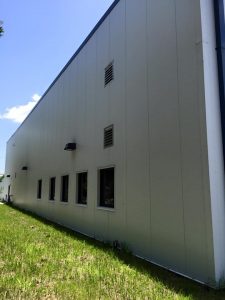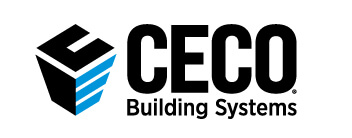Benefits of Designing with Insulated Metal Panels
Posted on April 17, 2017 by Ceco Building Systems Have you ever wondered why there is an increasing push for insulated metal panels, or sandwich panels, in the industry, and how you can benefit from using it in the design and fabrication of your building? The Metal Construction Association (MCA) defines insulated metal panels (IMPs) as “lightweight composite exterior wall and roof panels with metal skins and an insulating foam core.” Their superior insulating properties, increased spanning capabilities and single-step installation make them efficient and cost-effective, particularly when compared to other wall assemblies. And IMPs are available in an assortment of colors, widths, profiles and finishes, allowing for a wide variety of aesthetic appearances for walls and roofs. Let’s look at some of the specifics behind these benefits.
Have you ever wondered why there is an increasing push for insulated metal panels, or sandwich panels, in the industry, and how you can benefit from using it in the design and fabrication of your building? The Metal Construction Association (MCA) defines insulated metal panels (IMPs) as “lightweight composite exterior wall and roof panels with metal skins and an insulating foam core.” Their superior insulating properties, increased spanning capabilities and single-step installation make them efficient and cost-effective, particularly when compared to other wall assemblies. And IMPs are available in an assortment of colors, widths, profiles and finishes, allowing for a wide variety of aesthetic appearances for walls and roofs. Let’s look at some of the specifics behind these benefits.
Benefits to Design Professionals:
Design Flexibility: Insulated metal panels are available in a variety of flat and corrugated surfaces suitable for exterior walls, interior walls and roofs. IMPs are strong enough to allow for fewer structural supports than single-skin panels due to greater spanning and load-bearing capabilities, making them easier to integrate into building designs. They come in multiple profiles that can be used in either horizontal or vertical designs, including the availability of custom modular widths and factory-formed corners. Rounding things out is the full range of colors, reveals, and detail accessories that can support or enhance any design. They are also available with applied finishes to create a stucco, wood and other aesthetics.
Environmentally Friendly: It is common for a significant portion of the steel used in IMPs to come from recycled materials. Further, the insulating properties of IMPs with significant R-values can meet or exceed current energy codes and contribute toward credits in the Leadership in Energy and Environmental Design (LEED) Green Building Rating System. Because of the higher R-value insulation used in IMPs, less insulation space is needed in wall assemblies compared to other wall systems.
Fire-Resistant Solutions: In cases where one-, two- or three-hour fire-resistance ratings need to be part of the design, composite IMPs are available, using non-structural mineral wool insulation fabricated and tested to achieve the needed fire ratings.
Benefits to Construction Trades:
Ease of Installation: Since the interior and exterior faces of insulated metal panels can act as the finished surface, and the panel provides the required thermal, air, vapor and weather barrier for an exterior wall, they take the place of many separate products. This means there are fewer vendors and trades to manage during construction, streamlining the process and saving on costs. And IMPs are unaffected by most weather conditions, which allows flexibility in meeting construction time schedules.
Quick Construction Time: Most insulated metal panels are attached with a concealed fastener system in the side joint that streamlines their installation. This allows them to be quickly installed in a single step, significantly reducing construction time and getting “closed in” sooner.
Benefits to Building Owners:
Cost Effectiveness: The design flexibility and construction benefits noted above allow owners to capitalize on reduced first costs of the building. In addition, the energy efficiency, long term durability, and ease of maintenance typical of IMPs can save on operation costs as described below.
Energy Efficiency: The higher R-values possible with insulated metal panels means better control of heat flowing into or out of the building. Better heat flow control means better control of the energy, and associated costs, used to heat and cool the building.
Strength and Durability: The strength of the metal, including the presence or absence of corrugations, combined with the proven structural capabilities of the foam core, determine the overall strength of IMPs. This composite structural system provides their initial strength plus the ability to be durable enough to resist impacts and other forces during operation.
Longevity: Metal buildings using IMPs have been shown to last quite well as evidenced by decades of use. In most cases, the quality and strength of the steel can be selected to resist the conditions at the building. Similarly, the type of finish can be selected to withstand weather and operating conditions. Depending on local environmental conditions, their projected life could span 50 to 60 years and beyond.
Low Maintenance: Because of the inherent strength, durability, and longevity of IMPs, they typically require minimal maintenance. That means they can help owners save on annual operating budgets as well as long-term capital replacement projects.
With their simplicity of concept, design flexibility, efficient construction, and long-term performance, it is easy to see why insulated metal panels carry benefits for everyone involved. Visit our products or contact a rep to learn more.

